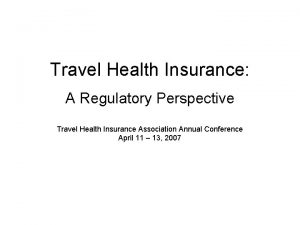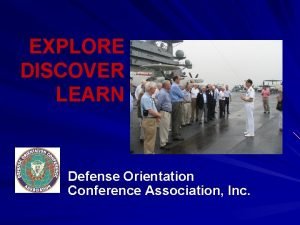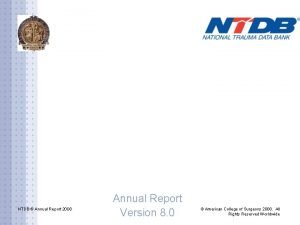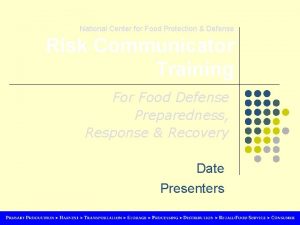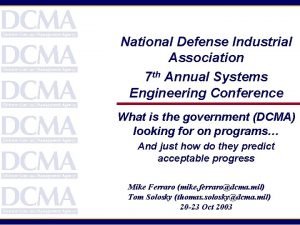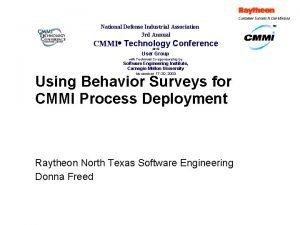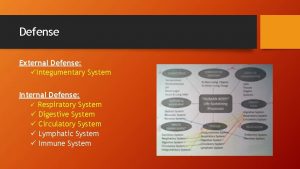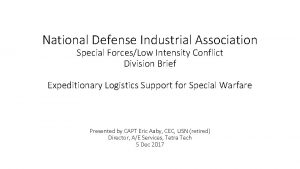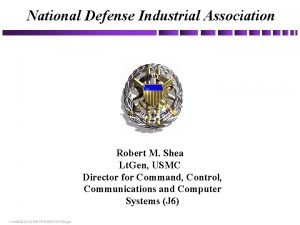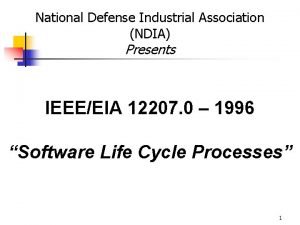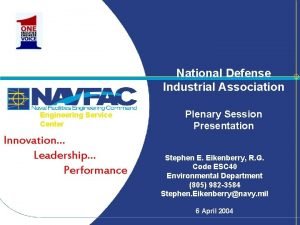National Defense Industrial Association 20 th Annual TE














- Slides: 14

National Defense Industrial Association 20 th Annual T&E Conference Verily, Vortices, Validation, and Vigilance – T&E Lessons for V-22 Brent A. Crabtree March 3, 2004 9/30/2020 -1

Outline • V-22 T&E Overview • Verily, OT confirmed DT results • Our understanding of Vortex Ring State was inadequate • Validation of emergency procedures was incomplete • Vigilance – Focus on learning what we need to know “Men occasionally stumble over the truth, but most of them pick themselves up and hurry off as if nothing had happened. ” Winston Churchill 9/30/2020 -2

V-22 Overview • Takes off and lands like a helicopter • Flies like an airplane – Cruises at 240 knots – Max speed 267 knots • Will perform USMC medium lift mission – Replaces CH-46 E and CH-53 D – 24 troops or 10, 000 pound external lift • Will enhance USMC operational flexibility 9/30/2020 -3

V-22 History 80 81 82 83 84 85 JVX Program 86 87 88 89 90 91 92 93 94 95 96 97 98 99 00 01 02 04 05 Redesign and Retest Engineering and Manufacturing Development Full Scale Development 03 SECNAV Approves EMD Programmatics Navy Lead LRIP I MS II+ (DAB) MS II (DAB) BRP LRIP 2 LRIP AAC LRIP 3 V-22 “Cancelled” LRIP 4 Aircraft Deliveries 7 8 EMD Aircraft 9 123456 FSD Aircraft 10 0 Mishaps DT IIA 11 21 31 41 15 22 32 42 16 23 33 43 12 24 34 44 25 35 45 13 17 36 46 18 26 27 37 47 14 38 48 19 28 29 39 49 20 30 40 50 19 7 4 IT-IIA/B/C/D DT IIB HROD Testing OT IIA 9/30/2020 -4 OT IIB OT IIC OT IID OPEVAL OT IIF OPEVALII

V-22 Developmental Testing IT-IIA/B/C/D DT-IIA&B 92 93 94 95 96 97 98 99 00 01 02 03 04 • 90 5 91 years and 1, 374 flight hours of integrated developmental Engineering and Manufacturingtesting ? ? ? Full Scale Development 81 82 83 84 85 86 87 88 • Two FSD aircraft, 4780 flight hours, 150 hours of ground and engine testing JVX Program 89 Development • Demonstrated potential for intended missions • 5 Programmatics Enhancing Characteristics • Started with. Approves FSD EMD aircraft and concluded SECNAV MS EMD II+ (DAB) aircraft LRIP I with BRP Navy Lead • 57 Part I Deficiencies – Excessive pilot workload in hover – Inaccurate vertical velocity indicator – Excessive rotor downwash – Unreliable Hydraulic System Aircraft Deliveries • Failed DT Reliability and Maintainability thresholds 05 LRIP AAC MS II (DAB) LRIP 2 LRIP 3 • Final report - 30 Part I Deficiencies LRIP 4 – Low reliability 21 31 required 11 15 inputs – Excessive lateral control 41 7 22 32 42 12 16 23 33 43 process to 34 44 8 1 2 3 4 5– 6 Navy uses Waiver 17 24 13 25 35 45 EMD 26 36 46 to FSD Aircraft acknowledge 9 18 proceed and 27 37 47 Aircraft failures 14 28 38 48 19 10 29 39 49 OPEVAL! 20 30 40 50 V-22 “Cancelled” 0 Mishaps DT IIA 19 7 4 IT-IIA/B/C/D DT IIB HROD Testing OT IIA 9/30/2020 -5 OT IIB OT IIC OT IID OPEVAL OT IIF OPEVALII

V-22 OPEVAL • • • 9/30/2020 -6 Adequate Test Scope – 804 flight hours on 4 aircraft from first low-rate initial production lot – Multiple test locations on East/West coast and Yuma Desert – Included three periods of shipboard testing – Numerous representative mission segments or tasks – Demonstrated mission profiles associated with Key Performance Parameters (KPPs) Funding priority had been DOT&E: Effective, but with concerns placed on meeting KPPs – Vortex Ring State – Operational limitations DOT&E: Not Suitable – Marginal mission reliability Verily, DT was correct! – Excessive maintenance manpower required – Inadequate availability Failures that had been – Inaccurate and incomplete documentation found had not been fixed – Non-useful diagnostics – Poor interoperability, notably communications – Shipboard capability to handle multiple MV-22 s untested

Vortex Ring State during OPEVAL April 8, 2000 – Marana, Arizona High Gross Weight Night Landing Under Goggles Airspeed: 180 Kts AGL: 3000 ft High Rate of Descent with low airspeed resulted in Vortex Ring State Condition ROD: >2500 fpm Airspeed: 100 Kts AGL: 1000 ft HROD DT had been curtailed. OT pilots were not sensitive to VRS ROD: >2000 fpm Airspeed: 40 Kts 10 -15 Kt Tail Wind 9/30/2020 -7 AGL: 300 ft

Program Interrupted • 5 Dec 2000, Milestone III Briefing • ASN (R, D&A) placed FRP decision on hold to get answers on 6 issues • Among his concerns were the issues raised by DOT&E 11 Dec 2000 New River, NC Routine Training Airspeed: 178 Kts AGL: 1600 ft 1923 hours Hydraulic Line Failure 9/30/2020 -8

Incomplete Validation • Dual hydraulic failures tested in the laboratory – Software gave correct warning • Emergency procedures tested in simulators – Pilots knew how to respond to warnings • End-to-end simulation of hydraulic failures coupled with pilot reaction never tested • Pilot-in-the-loop testing might have discovered the software anomaly 9/30/2020 -9

Vortex Ring State since OPEVAL 9/30/2020 -10 • V-22 returned to flight May 2002 • Over 1150 hours DT, much in HROD • Testing confirmed VRS model predictions • Onset of VRS occurs at higher rates of descent, but higher airspeeds than conventional helicopters • 12 Rolloffs to date • Forward tilt of nacelle provides robust recovery in most situations

Vigilance – Refocus the program • What do we need to learn? – Address issues from the Blue Ribbon Panel, NASA Ames Study, DOT&E, and Congress. • Fix what we can. – Redesigned flight control software. – Re-rout hydraulic lines and electrical wiring in the nacelles – More secure fasteners and better access in the nacelles. • Proceed with caution – Prior to return to flight, conduct extensive hardware-in-the-loop, pilot -in-the-loop testing – A detailed, event-based flight test program began in May 2002. – Progressive lengthening of inspections from 2 to 35 hours. 9/30/2020 -11

Vigilance – Understand VRS • If Marana conditions were flown today, the V-22 would respond in the same way. • What has changed: – Knowledge about VRS consequences is widespread in the V-22 community. – Extensive HROD testing confirmed VRS envelope; operating limitations appear adequate for normal conditions; more investigation underway – Simulators, flight syllabus, and NATOPs emphasize avoiding the phenomenon. – HROD warning system is present for both pilots and appears functional. – Vertical speed indicator has been improved. – VRS recovery techniques at altitude have been demonstrated and are understood. 9/30/2020 -12

Vigilance – Return to Operational Testing • OPEVAL I demonstrated KPPs in limited operational environments. – V-22 demonstrated significant improvements in speed, range, and maneuverability. • Some pure-helicopter mission tasks are better performed by CH-53 E & UH-1 Y. – Inherent tiltrotor design raises some operational limitations. – OPEVAL II will evaluate the operational impact of these limitations. • OPEVAL II will focus more on mission performance with multiple aircraft in ship-to-shore operations. 9/30/2020 -13

Conclusion The V-22 program illustrates two approaches: Focus on cost and schedule O Curtailed developmental testing O Deferred correction of reliability failures O Meet KPPs, but only in limited operational environments Be vigilant and proceed with caution ü Identify and address all the issues ü Eliminate known reliability failures ü Revise operational concepts as needed ü Begin OT only after planned testing is finished ü Progress to realistic combat operations in OT The second approach is more appropriate for T&E of new rotorcraft designs 9/30/2020 -14
 Nonspecific defense mechanisms
Nonspecific defense mechanisms American psychiatric association annual meeting 2020
American psychiatric association annual meeting 2020 Travel health insurance association annual conference
Travel health insurance association annual conference Vermont association of criminal defense lawyers
Vermont association of criminal defense lawyers Air defense artillery association
Air defense artillery association Aerospace and defence industries association of europe
Aerospace and defence industries association of europe Doca defense
Doca defense Aircollab
Aircollab National trauma data bank annual report 2020
National trauma data bank annual report 2020 Is national defense excludable
Is national defense excludable Is national defense excludable
Is national defense excludable Is national defense excludable
Is national defense excludable National center for food protection and defense
National center for food protection and defense Industrial packaging association
Industrial packaging association National industrial recovery act of 1933
National industrial recovery act of 1933


